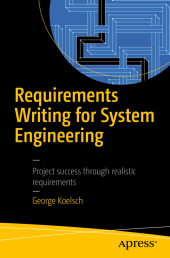 Neuerscheinungen 2016Stand: 2020-02-01 |
Schnellsuche
ISBN/Stichwort/Autor
|
Herderstraße 10
10625 Berlin
Tel.: 030 315 714 16
Fax 030 315 714 14
info@buchspektrum.de |

George Koelsch
Requirements Writing for System Engineering
1st ed. 2016. xxiii, 401 S. 3 SW-Abb., 15 Farbabb. 235 mm
Verlag/Jahr: SPRINGER, BERLIN; APRESS 2016
ISBN: 1-484-22098-6 (1484220986)
Neue ISBN: 978-1-484-22098-6 (9781484220986)
Preis und Lieferzeit: Bitte klicken
Tagline: Project success through realistic requirements
Learn how to create good requirements when designing hardware and software systems. While this book emphasizes writing traditional "shall" statements, it also provides guidance on use case design and creating user stories in support of agile methodologies. The book surveys modeling techniques and various tools that support requirements collection and analysis. You´ll learn to manage requirements, including discussions of document types and digital approaches using spreadsheets, generic databases, and dedicated requirements tools. Good, clear examples are presented, many related to real-world work the author has done during his career.
Requirements Writing for System Engineeringantages of different requirements approaches and implement them correctly as your needs evolve. Unlike most requirements books, Requirements Writing for System Engineering teaches writing both hardware and software requirements because many projects include both areas. To exemplify this approach, two example projects are developed throughout the book, one focusing on hardware and the other on software.
This book
Presents many techniques for capturing requirements.
Demonstrates gap analysis to find missing requirements.
Shows how to address both software and hardware, as most projects involve both.
Provides extensive examples of "shall" statements, user stories, and use cases.
Explains how to supplement or replace traditional requirement statements with user stories and use cases that work well in agile development environments What You Will Learn
Understand the 14 techniques for capturing all requirements.
Address software and hardware needs; because most projects involve both.
Ensure all statements meet the 16 attributes of a good requirement.
Differentiate the 19 different functional types of requirement, and the 31 non-functional types.
Write requirements properly based on extensive examples of good ´shall´ statements, user stories, and use cases.
Employ modeling techniques to mitigate the imprecision of words.
Audience
Writing Requirements teaches you to write requirements the correct way. It is targeted at the requirements engineer who wants to improve and master his craft. This is also an excellent book from which to teach requirements engineering at the university level. Government organizations at all levels, from Federal to local levels, can use this book to ensure they begin all development projects correctly. As well, contractor companies supporting government development are also excellent audiences for this book.
Part I: The Foundation of Requirements
1. The Importance of Requirements
2. What Makes a Good Requirement?
3. Specialized Language
Part II: Types of Requirements
4. Functional Requirements
5. Non-Functional Requirements
6. Lists of Items and the Order of Steps and Data Elements
7. Data Interfaces and Documents
8. Physical Requirements
Part III: Cradle to Grave Requirements
9. How to Collect Requirements
10. User Interface Requirements
11. Managing Requirements
Part IV: Alternatives to Shall Requirements
12. Supplementing or Replacing Standard Requirements
13. User Stories
14. Use Cases
15. Revisiting Requirement Problems and Their Solutions
Part V: Appendixes
art v:="" appendixes
16. A. Acronyms and Abbreviations
17. B. Requirements Documents
18. C: Section 508 Compliance
19. Glossary
20. Bibliography


